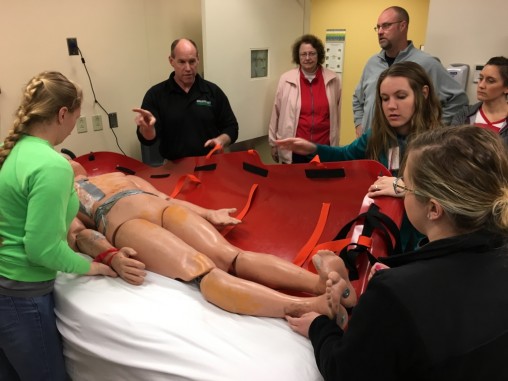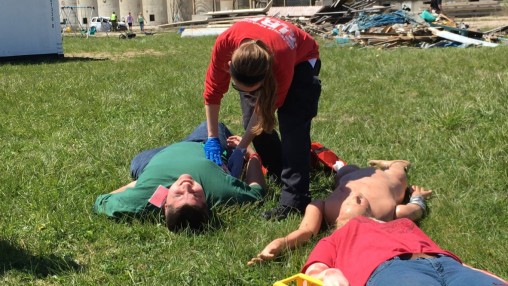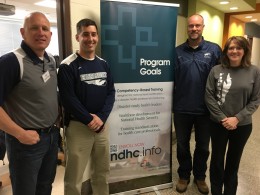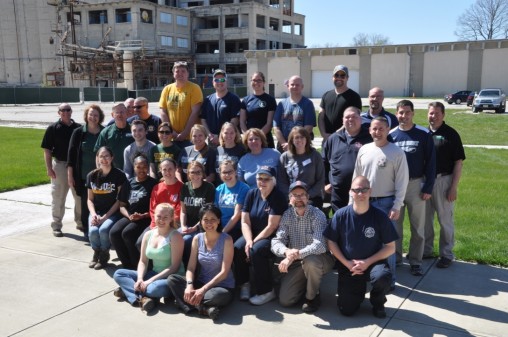
Interprofessional teams participated in a four-day advanced disaster life saving course, which included learning techniques to transport patients safely up and down flights of stairs during an emergency. (Contributed photos)
Story contributed by Stephanie Davis
Does your place of employment or school have a preparedness plan? Where is it found? What do you think of it? These are some of the questions that Sherry Farra, director of Wright State’s National Disaster Health Consortium (NDHC), asks participants as they learn, experience, assess and discuss disaster concepts.
“Workforce leaders are so immersed in day-to-day business that they don’t think about a location’s capacity to care for its community during a disaster nor do they think about working collaboratively until they are forced to do so,” said Fara.
Rosalie Mainous, dean of the College of Nursing and Health, has a vision for disaster response at Wright State University.
“In order for healthcare to be effective during disasters, training needs to be interprofessional. Health care and also non-medical workforce professionals need to be able to work together, share expertise and communicate with each other to form a cohesive team during a response,” said Mainous.

Tornado alley training.
Representative Rick Perales, Ohio district 73, is a supporter of disaster preparedness. He agrees that disaster training helps leaders make better decisions, helps health care employees take action based on established protocols and enhances awareness with the general public of what to do in an emergency.
“The National Disaster Health Consortium is a model for disaster health training. Everyone in the U.S. should be receiving disaster training,” said Perales. “Why would we wait for a disaster to strike before learning what we should and could do to save lives? It’s not a matter of if but when a disaster will occur. The U.S. is pretty good about responding to disasters, but businesses and schools need to get involved by learning disaster protocols so everyone is on the same page, panic is reduced and safety and wellness are focal points.”
In addition to firefighters, emergency medical technicians, nurses and military personnel enrolling in the various training options that NDHC offers, school districts are now seeing the value of disaster health training.

From left: Kettering City Schools team members Jeff Renshaw, Phil Hacker, Dan Von Handorf and Betina Irwin.
“It’s really nice to see Fairmont High School is taking a proactive approach to disaster preparedness,” says Farra. “Fairmont brought a team of four members to this week’s onsite training at the National Center for Medical Readiness. They’ve shared really great concerns from a school employee’s perspective and have been discussing needs and challenges related to school disaster preparedness.”
“School leaders should definitely attend disaster training,” says Dan Kirkpatrick, retired chief of nursing at Wright-Patterson Air Force Base and one of the disaster trainers. “Just as hospitals are tasked with providing medical assistance to our community, schools are tasked with providing education and safety to our children. We need to prepare school personnel before a disaster occurs not after. We also need community members to work together.”
Dan Von Handorf, director of students services for Kettering City Schools, says the NDHC training has prompted great conversations with his team, which included a high school unit principal, building and grounds supervisor and coordinator of school nursing.
“When Dan Kirkpatrick, mayor of Fairborn, suggested I attend a disaster life support class, I wasn’t sure how disaster training would directly apply to our school district,” Von Handorf said. “After attending an all-day basic disaster training course with Dan last week, it gave our team a lot to think about. Today, our team is completing the final day of a four-day NDHC advanced disaster training course where we have been learning and practicing sheltering requirements and disaster protocols. We are excited to get back to our district and use this new knowledge to improve our school district plans.”

Participants in the advanced disaster life saving course sponsored by the National Disaster Health Consortium and held at Wright State’s National Center for Medical Readiness in Fairborn.
The course consisted of firefighters, EMS coordinators, nursing students from Wright State and area colleges, Wright State Boonshoft School of Medicine students, a Fairmont High School team and Wright State and Sinclair Community College faculty.
In addition, career tech teachers and their students from Stebbins High School’s Exercise Science program and Great Oaks Career Campus’ Diversified Health Occupations program at Live Oaks served as medical role models to help make disaster scenarios real.
“It’s a blend of workforce professionals and students from several disciplines. We should be training for disasters in an interdisciplinary learning environment because we will have to work with varying groups of experts when disaster strikes.” said Farra.
While the United State has developed standards for disaster preparedness, Kirkpatrick said there’s more work to be done at the local level to prepare schools, hospitals and the workforce for disasters.
“Seeing participants in this course work together is a great start,” he said.

 Wright State medical students bring medicine to life for Mini University preschoolers
Wright State medical students bring medicine to life for Mini University preschoolers  Wright State Theatre to present rom-com musical ‘The Wedding Singer’
Wright State Theatre to present rom-com musical ‘The Wedding Singer’  Heavy metal learning
Heavy metal learning  State grants to bolster Wright State’s electric vehicle and advanced manufacturing training for students
State grants to bolster Wright State’s electric vehicle and advanced manufacturing training for students  Wright State partners with local universities, hospitals to expand mental health care for students
Wright State partners with local universities, hospitals to expand mental health care for students 